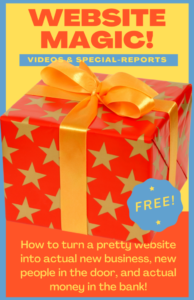 Many business owners, and many people who need to sell as part of their job frequently fail to realize that they don’t just sell their offering. They don’t just sell their products and services.
Many business owners, and many people who need to sell as part of their job frequently fail to realize that they don’t just sell their offering. They don’t just sell their products and services.
The most basic thing a person sells is himself (or herself).
This ties back into that primary tenet of multi-touch marketing: that people like to buy from people they know, like, and trust.
In the first secret key to successful marketing, which states that the most basic element to increasing sales is to increase the number of interactions with the prospect, we have a working guideline for how to increase your sales.
What do you say?
But what are you going to do? What are you going to say in those increased interactions with your prospects?
Well yes, you’re going to spend some time selling your products and services, but the largest part of your time is going to be in effect selling yourself. Now that’s not some weird kind of prostitution. It just means being a real human, hopefully a helpful and likable human, and in general assisting the prospect in getting what he wants from life.
Now you don’t want to become an unpaid consultant for your prospects. You don’t want to pander to every silly whim. You don’t want them to be in charge of the entire thing. That would be like a doctor who examined nothing except what the patient told him to examine and who prescribe nothing except what the patient told him to prescribe.
The patient doesn’t know what’s needed. And neither do your prospects know what’s needed, inside your field of expertise.
But, like a good doctor, you can be helpful, supportive, friendly, and kind. Do that job right, and the prospect will come to know you, like you, and trust you.
Selling yourself
We live in a world where people are very skeptical about many things. And with damn good reason. The general belief of the average person is that if it sounds too good to be true it probably is not true.
Because of this preconceived notion — which most of us possess — it can be very difficult to sell a person anything. People love to buy. But they hate to be sold something.
The very fact that somebody is “pushing” something at them, is reason enough to automatically resist both the thing being pushed, and the person doing the pushing.
Who do you trust?
We all look for somebody we can trust.
Have you ever gone out and bought something because somebody you know said it was a good thing? I have, and you have to. That’s why referral business is so valuable. Sometimes we call it “word of mouth” and it’s more valuable than any advertising you can buy.
Is that because those words were really catchy? Not at all. It’s because those words came out of the mouth of somebody that the guy trusted.
Trust on the internet?
Well, any thing which makes a contact more anonymous tends to reduce trust. For example, when you talk to someone on the phone you don’t get all the signals that are available in a face-to-face meeting. Like, if the guy has shifty eyes, you will never know it over the telephone.
E-mail is even worse, because the sound of the voice has disappeared. Many years ago, a popular actress named Sally Struthers got a job doing TV commercials for a trade school. I don’t know what her difficulty was at that time, but her voice is she spoke was tremulous and shaky, as if she were terrified at that very moment. I don’t know about you, but I paid no attention to what she was saying, because I was so caught up in the weird tremor in her voice.
But e-mail, I would have never heard that tremor.
How much time do you have?
Once upon a time, most sales were done face-to-face. You may even recall that, once upon a time there was such a thing as a “traveling salesman” but nowadays such an outside salesman primarily exists only in specialized fields such as heavy equipment or other very large things that cost a lot of money.
For most of the things that most of us sell traveling around and selling them face to face to one person at a time is cost prohibitive. When the telephone came in, many types of sales change from travel to telephone.
With the Internet, another such shift has already happened. E-mail has replaced much of the letters and the direct marketing brochures of the past.
And in fact, since we already know that the most basic element of increased sales increasing the number of interactions with the prospect… but this can only effectively be done by automating the process… then we have to work a little harder building a relationship which would have been quicker and easier if we were meeting face-to-face.
What is in these “increased interactions?”
Here is where we have to use a little bit of smarts to earn the trust of people, especially if some of our selling is not face-to-face. (And many of these automated interactions are in fact not done face-to-face.)
So what is the content in these “automated interactions ?”
- You spend a little time introducing yourself, and don’t go leaping into any sales pitch
- you provide some helpful information; in your field, you are a gold mine of information
- you provide a comfortable amount of “self-revealing” information that is personal
- you provide some gently offered information about your offering, in a way that is helpful, interesting, and educational to your prospect, on the assumption that your prospect does have some interest
Remember: you can’t sell anyone a product or service until you really do have their trust. That means that, no matter what the content of initial conversations, the last thing to bring would be some kind of pushy selling tactic.
You do, however, gently lead them toward whatever their “next step” might be. For example if you sell barbecue pits, you might offer to send them some recipes for barbecue sauce or potato salad. (And inside that document of recipes, there might be made mention some of the advantages of using a modern barbecue pit, and that they could learn more about those very modern barbecue pits with a simple phone call. To you.)
Step by step. Inch by inch.
Since most of these interactions are automated — a sequence of automated e-mails, telling the story, or a free gift, or two, or an interesting video, etc. etc. — they can be set up once and then run automatically.
If you are providing valuable information, it’s no less valuable because it was printed out and that sure is better than your having to say the words every single person over and over and over again.
Two-way communication
And in the process, you want them to reach out now and then. Just like in a conversation when two guys are hanging out and shooting the breeze, one guy says something, then the other guy says something.
Over time, this is exactly what you and your prospect are doing. And you are creating it. Even when using automated means to provide this benefit and this conversation, you are still providing the benefit and the conversation.
Your competition is probably providing neither the benefit nor the conversation.
That’s why, if you do it this way, you are building a relationship, you are engaging in multi-touch marketing, and your sales will just naturally increase.
